Topics - B29s in the Korean War
|
 |
Boeing B-29 Superfortress
|
| |
|
|
Introduction
According to Lt. Col. George A. Larson, USAF (Ret.):
"B-29s flew 1,076 days during the 1,106-day air war in Korea, dropping 160,000 tons of bombs on Communist
targets--a greater bomb tonnage than had been dropped on Japan during World War II. Regardless of the
many obstacles they faced, B-29 crews performed brilliantly, destroying industrial and military strategic
targets in North Korea and supporting U.N. ground troops. The FEAF lost a grand total of 1,406 aircraft
and suffered 1,144 men killed and 306 wounded during the war. Thirty FEAF men who had been declared
missing were eventually returned to military control, 214 POWs were repatriated under the terms of the
armistice agreement, while 35 men were still being held in Communist captivity as of June 1954. The
men who flew and supported the B-29s in the Far East Command were an important part of the air war over
Korea, but their contribution has seldom been recognized."
[Source: Lt. Col. George A. Larson, "Final Glory of the Boeing B-29 Superfortress", Military History,
March 1998]
This page of the Korean War Educator opened in April of 2015 to educate the public about B-29s in Korea.
It is the direct result of the willingness of James Othrow of Estes Park, Colorado to share with
the KWE memories of his experiences as a ground crew member for the B-29 known as the "Lemon Drop Kid".
The KWE realized that there is a great lack of information on the Internet about the role that the B-29s
and their crews had in American history during the Korean War. Following an online interview with
Mr. Othrow and the decision to create this B-29 page on the Korean War Educator, other B-29 veterans and
their families stepped forward to offer their assistance to build this page.
Adding information and photographs to it is an ongoing process. Much still needs to be
researched. For instance, although the KWE has compiled a list of fatalities due to enemy action
or mechanical failure, we were not always successful in locating the names of others who were on flight
crews on the date the action took place. For instance, we know the names of the casualties on Vicious
Roomer #44-62042 on March 28, 1952, but we don't know the names of the other crew members that flew with
them that fateful day. When loss of life was caused by something other than combat action, those
fatalities generally do not show up on the official KORWALD loss database. It is difficult to
honor those who paid the ultimate sacrifice if we don't know they paid it. The public is invited
to help expand this page with further information by contacting Lynnita
Brown, 111 E. Houghton Street, Tuscola, IL 61953; phone 217-253-4620 (or Thursday-Saturday 10-3 at 217-253-5171);
e-mail Lynnita.
Page Contents:
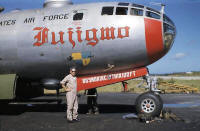
"FUJIGMO" is an acronym with special meaning for B-29 crew.
(Click picture for a larger view) |
- Introduction
- About the B-29
- B-29 Master List
- Black Tuesday
- Korwald (Korean War Aircraft Loss Database)
- Last Men Standing - by Bud Farrell
- Links to B-29 related websites
- Lists (Ashley Five, Nielsen-Henderson, 59 List, 71 List)
- Literature
- Losses (B-29 flight crew)
- Losses/Damages (B-29 aircraft)
- Losses (91st Strategic Reconnaissance Squadron)
- Maj. William Sawyer's Crew (downed 11/20/1952)
- Mac McGill's Website (B-29s in the Korean War)
- Memoirs & Memories
- Allan, Dean S. - B-29 left gunner
- Baker, John L. - B-29 navigator
- Durham, Clyde C. - B-29 tailgunner
- Gustine, Frank - B-29 flight crew member (COMING SOON)
- Harper, Herb - B-29 ground support
- Hayes, Ralph W. - B-29 tail gunner
- Kidd, Terry L. - B-29 Down Over Korea
- Othrow, James - B-29 ground support
- Pitts, Denny - B-29 Andy's Dandys
- York, Ed - B-29 CFC gunner, Snugglebunny
- Mission Log - Herb Everett
- Mission to Kwaksan, North Korea - by Howard Whitley
- Newspaper Articles
- Photo Albums
- Remembrance (COMING SOON)
- Searching for Answers
- Steadfast and Courageous: FEAF Bomber Command
- Tragedy on Guam
- Tragedy at Fairfield-Suisan AFB
- Yalu Railroad Bridge Mission
- Readers' Comments
Back to Page Contents
About the B-29
The last B-29 in squadron use retired from service in September 1960, but before that the Boeing B-29
Superfortress made history on the Korean peninsula. When the Korean War ended on July 27, 1953, the
B-29s had flown over 21,000 sorties, nearly 167,000 tons of bombs had been dropped, and 34 B-29s had been
lost in combat (16 to fighters, four to flak, and fourteen to other causes). B-29 gunners had accounted
for 34 Communist fighters (16 of these being MiG-15s) probably destroyed another 17 (all MiG-15s) and damaged
11 (all MiG-15s). Losses were less than 1 per 1000 sorties.
By the mid 1950s the majority of B-29s used in World War II and the Korean War were obsolete.
Some were taken to Forbes AFB for disposal. Others were flown from Tindall AFB to Aberdeen,
Maryland, where they were scrapped. The B-29 "As You Like It" (44-27277) was salvaged at McClellan
AFB on July 14, 1954. Hundreds of B-29s wound up in the "grave yard" at Davis-Monthan AFB,
Arizona. Forty B-29s were taken to China Lake NAS in the late 1950s to use for target practice.
A handful are in museums around the world.
Back to Page Contents
Specifications:
General characteristics
- Crew: 11 (Pilot, Co-pilot, Bombardier, Flight Engineer, Navigator, Radio Operator, Radar Observer,
Right Gunner, Left Gunner, Central Fire Control, Tail Gunner)
- Length: 99 ft 0 in (30.18 m)
- Wingspan: 141 ft 3 in (43.06 m)
- Height: 27 ft 9 in (8.45 m)
- Wing area: 1,736 sq ft (161.3 m²)
- Aspect ratio: 11.50:1
- Empty weight: 74,500 lb (33,800 kg)
- Loaded weight: 120,000 lb (54,000 kg)
- Max. takeoff weight: 133,500 lb (60,560 kg) ; 135,000 lb plus combat load
- Powerplant: 4 × Wright R-3350 -23 and 23A Duplex Cyclone turbosupercharged radial engines, 2,200
hp (1,640 kW) each
- Zero-lift drag coefficient: 0.0241
- Drag area: 41.16 ft² (3.82 m²)
Performance
- Maximum speed: 357 mph (310 knots, 574 km/h)
- Cruise speed: 220 mph (190 knots, 350 km/h)
- Stall speed: 105 mph (91 knots, 170 km/h)
- Range: 3,250 mi (2,820 nmi, 5,230 km)
- Ferry range: 5,600 mi (4,900 nmi, 9,000 km, [63])
- Service ceiling: 31850 ft [21] (9,710 m)
- Rate of climb: 900 ft/min (4.6 m/s)
- Wing loading: 69.12 lb/sqft (337 kg/m²)
- Power/mass: 0.073 hp/lb (121 W/kg)
- Lift-to-drag ratio: 16.8
Armament
- Guns:
- 10× .50 in (12.7 mm) Browning M2/ANs in remote-controlled turrets
- 2× .50 BMG and 1× 20 mm M2 cannon in tail position (the cannon was later removed)
- Bombs:
- 20,000 lb (9,000 kg) standard loadout.
Back to Page Contents
Clarifications & Terms
- Question: What is a "golf ball mission"?
- Answer: Usually a specialized mission using a single or lone bomber, such as on a Propaganda
Leaflet Dropping Mission.
- Question: What is a "spook" plane?
- Answer: It is a spy plane with a classified mission. According to Earl 'Mac" McGill,
"B-29 spook aircraft were modified to carry electronic detection equipment instead of bombs. They came
under frequent attack and many were lost. These aircraft were flown by true American heroes who will
never be recognized because their missions were top secret and never acknowledged. I write about a few
of them in my other book, Jet Age Man. Of particular personal concern was a crew commanded by
Lacy Neighbors. Their plane was shot down in the '50s over the Bering Straits and the crew perished.
After Neighbors was shot down, our (90SRW) missions into the area were cancelled. In a way, I owe that
crew my life."
- Question: Could a B-29 have more than one name?
- Answer: Yes. Many B-29s were used in World War II. A B-29 with the same serial
number as one used during the Korean War might have had different nose art and different names, depending
on crew changes, assigned bomb wing, and maintenance issues. According to Earl "Mac" McGill, "A
number of B-29s were recycled out of the DM boneyard with the original WWII nose art, that was changed
once in the KW theater. The 98th was especially fond of changing names, usually keeping the original
art intact. For instance, I suspect that "Koza" was changed to "American Beauty" because of the negative
connotation "Koza" implies. Koza was a village just outside of Kadena AF, its "business" section consisting
of mostly of bars and temporary housing for the world's oldest profession. That is a long sad story
in itself." Bud Farrell noted, "Some were changed as many as three times...apparently due to new
crews etc, but most were flown by several crews with one crew seldom “owning” a ship during the Korean
War."
- Question: Could the same name be given to two different aircrafts with different serial numbers?
- Answer: Yes, but not usually in the same time frame.
- Question: Why were some B-29s painted black on their underbellies?
- Answer: To make the aircraft less visible to the enemy during night missions. Bud Farrell
noted, "This was done particularly to not reflect search light beams! Ours in the 19th Bomb Group were
painted on July 24, 1952, about halfway through the war due to losses."
- Question: What is KORWALD?
- Answer: The Korean War Aircraft Loss Database was created
by the federal government to document the names of Air Force personnel who were MIA, KIA, injured, and/or
rescued as the result of an aircraft accident. The database provides name, rank, date of loss,
type of aircraft, and serial number of the aircraft. It is searchable by both name and date of
loss.
- Question: How many members were on a B-29 flight crew?
- Answer: According to Earl "Mac" McGill, eleven was normal. In forward pressurized compartment,
from nose, working aft: Bombardier, Aircraft Commander, Pilot, Engineer, Navigator, and Radio Operator.
In aft pressurized compartment: Central Fire Controller, Left Scanner, Right Scanner, Radar Operator,
and Tail Gunner. At a minimum, the Aircraft Commander, Pilot, and Engineer (three people) could get
the bird into the air, but regulations required both scanners and tail gunner--a six-man crew.
Other more popular crew position names were more often used than not, such as 'ring gunner' (CFC) and
left and right 'gunner' instead of 'scanner.'
Bud Farrell noted, "Test hop and or Transition Training crews were usually just five men, Aircraft Commander,
Pilot, Flight Engineer, and Left & Right Gunner/Scanners. The term 'Scanner' was more prevalent
in KB-29 Tankers and as Air Refueling Operator/Scanner! Most Gunners did NOT want to be called 'Scanners'!
On some Max Effort Missions, we carried another 12th crew member, an “E.C.M.” man, an Electro Counter
Measures Specialist in rear Radar/Gunners Compartment to jam enemy radar."
Earl McGill further noted: "Scanners were officially listed as 'gunners.' The difference, I believe,
depended on their function, re combat vs. training, etc. For example, persons occupying the right and
left blisters were not necessarily 'gunners' on all flights. I recall sitting in a blister during a
ferry mission, acting as 'scanner.' The 'scanner's' duty was to tell the crew if (usually when) an engine
did something it wasn't supposed to. B-29 engines were so temperamental that 'scanners' were required
on all flights. I recall a peacetime training flight where the left scanner called out, "Number two
on fire," and the A/C asking. "How bad?" The scanner replied, "I don't know; there's so much smoke that
I can't see." The A/C gave the bail out order but before we could get the hatches open there was a big
"bang!" and the fire went out. Luckily, we were directly over Ellsworth AFB SD and able to land. If
we'd been over Sinanju we'd never have made it home. Because of that incident, The Outlaw crash, and
many other hair-raising moments, the B-29 is the least favorite of all of the airplanes I've piloted.
You can read about another 'incident' in my article, "Milk Run Over North Korea", that appeared in the
Spring 2013 magazine of the AF Museum (Friends Journal)."
- Question: What is an "Evaluation Mission"?
- Answer: Periodically each crew was tested on procedure and proficiency. Most organizations
had what was called "A Standardization" crew who would fly with the regular crew, and observe their
proficiency. There was also a written exam included.
- Question: What was "SHORAN" and "LORAN"?
- Answer: Probably, the forerunner of the GPS systems now in use was "SHORAN" or Short Range
Navigation, and "LORAN", Long Range Navigation. The shoran operator could set up the target co-ordinates
at the beginning of the mission and the bombs would be dropped on that information. Armament maintenance
tested the bomb release mechanism, BEFORE the bombs were loaded to make sure the release system was
operating.
Back to Page Contents
B-29 Master List
This Master List of Korean War B-29s provides aircraft names and serial numbers. To view the list
click HERE.
Back to Page Contents
Black Tuesday
See
Black Tuesday on the Korean War Educator.
Back to Page Contents
Last Men Standing - by Bud Farrell
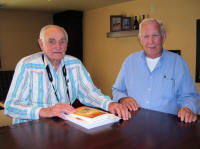
Don Heil on left, Bud Farrell
on right
(Click picture for a larger view) |
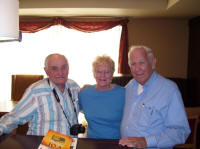
Don Heil, Carole Farrell, and
Bud Farrell
(Click picture for a larger view) |
Never a day - nor particularly a night - goes by that I don’t remember that just a few years ago
I had a phone call from the wife of our Korean War B-29 combat crew’s pilot, sadly advising me that
he had just passed away in the Guam Naval Hospital from a series of, and then one major, stroke. Marty
Martineau’s wife Carol told me his very last words after receiving Last Rites from a Catholic Priest
friend of his were," The Crew is waiting for me!” I reported this to Lynnita Brown of “The Korean
War Educator” web site, who does obituaries for veterans. I told her that I had tried to find
our crew bombardier, Don Heil, but that the Air Force Personnel Records Center reported to me that he
was deceased in 1985. They had me ever so briefly believing that I was the last man left and that,
hopefully, "the crew was perhaps now waiting for me." I was still trying to find one of his
relatives, so Lynnita searched the Internet and told me that there was a "Don Heil Builders" in Edgewood,
New Mexico, a few hundred miles north of Hobbs where he had been recalled from the Reserves in 1951--and
no more than a mile off Route 40, which I had perhaps taken at least 50 times from Durango, Colorado
to our previous home in Richardson, Texas. I called the number Lynnita gave me, expecting with
great final hope that I might find descendents of Don--a son or grandson carrying on a business that
Don may have started with his carpentry training at the Williamson Trade School in Media/Lima, Pennsylvania,
and work experience before his enlistment during World War II and his prior experience as the only member
of our Korean War B-29 crew to have flown in a B-29. Upon someone answering my telephone call
to "Don Heil Builders", I said, "My name is Bud Farrell and I am looking for anyone related to a Don
Heil who was our Bombardier during the Korean War." His reply was, “I’m looking at your picture!”
I said, "You’re WHAT?" He said again, “I’m looking at your picture!” I asked him, "Who the
hell are YOU?" That's when he told me, “This is Don Heil.” I yelled, “CAROLE, I HAVE DON HEIL
ON THE PHONE!” After 60 years Don was looking at the same Randolph Field Combat Crew Training crew picture
as I had on my home office wall! That phone call concluded my search of 32 years for him.
The Air Force Personnel Records Center had erroneously reported to me that Don had died
in 1985, a report of his passing a greatly exaggerated 27 years before Lynnita found him, and 60 years
of my searching!
Several weeks later, on September 17, 2012, Carole and I drove from home in Georgetown, Texas
(near Austin) to meet Don in Albuquerque, New Mexico...the first, but very best, reunion we ever had.
It was a day of recollections, memories, pictures, etc. A truly SENTIMENTAL JOURNEY! Don has now relocated
to historic Cape May Court House, New Jersey, to be closer to his two sisters after so many years and
two wars apart. Again, the way to a friend’s home is never far and I look forward to another reunion...so
much sooner than the last. ...and now we are TWO for whom “our crew is waiting in eternity”!
- Bud Farrell |
Back to Page Contents
Links to B-29 Related Websites & Other Helpful Websites With B-29 Information
Back to Page Contents
Lists - The "Ashley Five", "Nielsen-Henderson List" , The "59 List", The "71 List"
Although the government sometimes denotes B-29 casualties as "Killed in Action", not all of them were.
Many were taken prisoners of war. Not all of them were released to return to the United States when
the truce was signed. Some were held for several years more before release, and some were never returned
at all. The names of some of the Air Force POWs show up on three lists known as the Nielsen-Henderson
List, the "59 List", and the "71 List". The persons on this list have at least one thing in common--they
were interrogated by Soviet officials. Some were beaten unmercifully and tortured in other ways.
These three lists are available for viewing on the Korean War Educator's POW/MIA Topics page. All
three lists cross-reference the names of some POWs that our government listed as MIA or KIA, but were definitely
seen alive after their planes went down. Click on the lists below to see them. A number of Missing
in Action B-29 crew members can be found on them.
Back to Page Contents
Literature
- Allan, Dean S. The Twelfth Man - The Super Fortress Over North Korea: A B-29 Crew's Experience in Combat Over North Korea 1952. Allan was a left gunner. Book is now out
of print.
- Bruning, John R. Crimson Sky: The Air Battle for Korea. Bruning has authored
eight books, many of them military-related.
- Corbin, Lee. The Crash of 44-87741. The book details a B-29 crash that occurred
at Andersen AFB, Guam, on December 17, 1953.
- Costello, Ronald J. Diary of a Tailgunner. Costello was a tailgunner on All
Shook. He flew 27 missions over Korea.
- Davis, Larry. Planes, Names & Dames, Vol. II, 1946-1960. Several photos of
Korean War B-29 nose art can be found in this book.
- Dorr, Robert F. B-29 Superfortress Units of the Korean War. Dorr is an Air Force
veteran (1957-60) and a retired senior foreign service officer. He is the author of over 70 books.
- Farrell, Frank "Bud", No Sweat. Farrell was the left gunner on "No Sweat" during the
Korean War.
- Harden, Blaine. The Great Leader and the Fighter Pilot: The True Story of the Tyrant Who
Created North Korea and The Young Lieutenant Who Stole His Way to Freedom. Published by the
Penguin Group in 2015, this book gives insight on the B-29 in the Korean War as seen by the
North Koreans. It is based on declassified documents and interviews.
- Hudder, Vernon R. "Bob". The Brush of Angel Wings. Hudder flew 27 combat missions as
a navigator on a B-29 lead crew of the 98th Bomb Wing. His aircraft was Hearts Desire II.
Mr. Hudder died in 2009.
- Kiba, Steve E. The Flag--My Story: Kidnapped by Red Chinese. Kiba was a radio
operator on "Stardust Four Zero" when it was attacked by MiGs on January 13, 1953. He was taken
prisoner of war.
- Larson, George A. The Superfortress Final Glory: The Korean Air War, The Cold War's First
Aerial Combat. Larson is a retired Lieutenant Colonel in the Air Force and former strategic
intelligence officer with SAC.
- Livengood, Ralph. B-29 Navigator: Korean War 1951. Livengood, recipient of the
Distinguished Flying Cross, flew 36 missions in B-29s with the 19th Bomb Group out of Kadena.
- Marshall, Chester W. and Thompson, Warren. B-29 Photo Combat Diary: The Superfortresses
in WWII and Korea.
- McGill, Lt. Col. (USAF Ret.) Earl J. "Mac". Black Tuesday Over Namsi: B-29s vs MiGs
- The Forgotten Air Battle of the Korean War, 23 October 1951. McGill was there!
- Nijboer, Donald. B-29 Combat Missions: First-Hand Accounts of Superfortress Operations
Over the Pacific and Korea. Nijboer is a best-selling aviation author/historian/documentary
writer-producer and Smithsonian speaker.
Back to Page Contents
Losses (B-29 flight crew)
Click HERE
Back to Page Contents
Losses/Damage (B-29 aircraft & flight crews)
Back to Page Contents
Losses (91st Strategic Reconnaissance Squadron)
Capt. Jim Baird (USAF Ret.) compiled a list of significant B-29 losses associated with the 91st during
the Korean War. To read about them Click HERE.
Back to Page Contents
Maj. William Sawyer's Crew (downed 11/20/1952)
Back to Page Contents
Memoirs & Memories
Allan, Dean S. - B-29 left gunner
To view Dean's book, The Twelfth Man: A B-29 Crew's Experience in Combat Over North Korea 1952,
click HERE.
Baker, John L. - B-29 navigator
To view his memories of flying with the 98th Bomb Group, click
HERE.
Durham, Clyde C. - B-29 tailgunner
To view the memoir of B-29 tailgunner Clyde C. Durham,
click
HERE.
Gustine, Frank - B-29 flight crew member (COMING SOON)
Harper, Herb - B-29 ground support
To view the memoir of Herb Harper, click HERE.
Hayes, Ralph W. - B-29 tail gunner
To view a reminisce of Ralph Hayes, click HERE.
Othrow, James - B-29 ground support
To view the memoir of B-29 ground crew member, Jim Othrow,
click HERE.
Pitts, Denny - B-29 "Andy's Dandy's"
To view this reminisce of B-29 crew member Denny Pitts, click HERE. (coming soon)
York, Ed - B-29 CFC Gunner
To view Ed York's memories of being a CFC gunner on the Snugglebunny,
click HERE.
Back to Page Contents
Mission Log - Herb Everett
Vern Garner's crew was assigned to several aircraft, including Miss N.C., Lucifer, Dragon Lady, Four
Abreast, and others. The final aircraft they flew was known as "9999" or "Sure Thing"/"Four of a Kind".
The crew included:
- Bunnett, Bob - bombardier
- Everett, Herb - radio operator
- Futch, Carl - engineer
- Garner, Vern - aircraft commander
- Gold, Aaron - gunner
- Grable, John - navigator
- Klotz, Bernie - radio operator from Chicago, IL
- Martins, Bill - gunner
- Overbey, Jack - co-pilot
- Smith, Bobby - gunner
- Wilson, George - gunner
Herb Everett wrote,
"The first time we were put together as a crew was at Randolph AFB, Texas. As I recall, we
were the first group of crews training for overseas duty, this being shortly after the start of the
Korean War. We were there for 2 or 3 months, then sent to Davis-Montham (?) AFB in California
for processing for overseas. One of the funniest experiences while there was that we had to qualify
for "Survival Training" before going into combat. The AF had a real good survival training that
entailed a couple of weeks, but we didn't have that long, so they sent us on a 3-day "survival" trip
to the Sierra Nevada. We were supposed to "live of the land", catching fish to eat and snare rabbits,
etc. Well, as it turned out, we would have starved but for the fact that some of the officers
hitchhiked to a nearby town and came back with pies, candy and other goodies!"
As noted on the crew list, Everett was a radio operator on a B-29 out of Kadena during the Korean War.
He kept the following "mission log" that documents the various missions that he participated in as a member
of Vern Garner's flight crew. The mission log was sent to the Korean War Educator by Bernie Klotz's
stepson, John Thrash of Arlington Heights, Illinois. Herb Everett's Mission Log
[Key: + = formation; * = flown with crews other than Everett's; x = ECM mission. ECM
= equipment to jam enemy radar]
| Date - 1951 |
Mission |
Target |
Results |
Comments |
| May 28 |
#1 - + & * |
Pyongyang - night mission |
Good |
Flak |
| June 05 |
#2 - * |
Front lines - night mission |
Unknown |
None |
| June 12 |
#3 - * |
Front lines |
Unknown |
landed at Itazuke for gas |
| June 18 |
#4 - x |
Sunan airstrip at Pyongyang |
Very good |
Flak heavy |
| June 21 |
#5 - * |
Airfield north of Seoul (first golfball mission flown) |
Excellent |
only plane put 6 bombs in center of runway |
| June 24 |
#6 - + |
Airfield at Sinanju |
Excellent |
Moderate flak - close |
| June 27 |
#7 - * |
Troop concentration north of Seoul |
Unknown |
None |
| June 30 |
#8 - + |
East Pyongyang airfield |
Very good |
Light flak |
| July 06 |
#9 |
Marshalling yard in northeast Korea |
Fair |
Light flak |
| July 09 |
#10 - + |
Airfield at Sinanju |
Good |
Light flak, attacked by MiGs. Three MiGs shot down group lead ship. |
| July 12 |
#11 |
Night mission troop concentration |
Unknown |
First mission in new plane |
| July 18 |
#12 |
Night mission, troop concentration |
Unknown |
None |
| July 27 |
#13 |
Marshalling yard at Northeast Korea |
Fair |
None |
| August 11 |
#14 - + |
Marshalling yard in North Korea |
Unknown |
Col. Breckinridge along Bunnett has bomb fall on arm |
| August 14 |
#15 - + |
Barracks area NE of Pyongyang |
Good |
19th, 307th & 98th together, moderate flak |
| August 23 |
#16 |
Supply yards |
Unknown |
Golfball, truce talks end today |
| August 25 |
#17 - + |
Marshalling yard NE Korea 15 miles from Russian border |
Good |
98th, 307th &19th together |
| August 30 |
#18 - + |
Supply yard above Sinanju - MiG Alley |
Good |
Light flak close, two planes hit |
| September 10 |
#19 |
Cement factory (1), Supply yard (2) |
Poor |
Evaluation mission |
| September 12 |
#20 |
Supply yards (2) |
Good |
Evaluation mission |
| September 19 |
#21 |
Wonsan Supply Yard |
Fair |
Two shoran drops on airfield NE coast. Then supply yard |
| September 21 |
#22 |
Two airfields in NE Korea |
Good |
Evaluation mission |
| September 25 |
#23 |
Two airfields in NE Korea |
Good |
Evaluation mission |
| September 28 |
#24 |
Marshalling yard (last resort) |
Good |
None |
| October 02 |
#25 |
Steel factory (last resort) |
Very good |
None |
| October 04 |
#26 |
Airfield NE Pyongyang (Last resort) |
Fair |
None |
| October 19 |
#27 |
Night mission |
Good |
None |
| October 22 |
#28 |
Night shoran above Sinanju |
Unknown |
Enemy fighters in area. Made few passes. Couple bursts flak. One 19th plane
lost during day mission. 309th hi bad. 23 |
| October 25 |
#29 |
Night mission |
Good |
In three previous days eight 29s lost |
| October 30 |
#30 |
Night mission - enemy troops |
Unknown |
First time whole crew has flown together |
| November 02 |
#31 |
Night mission |
Unknown |
None |
| November 05 |
#32 |
Night mission |
Two shacks |
None |
| November 09 |
#33 |
Nigh shoran above Sinanju |
Unknown |
Heavy flak below us. Couple planes seen, but no attacks |
| November 11 |
#34 |
Night mission |
Good |
None |
| November 14 |
#35 |
Night Shoran |
Unknown |
Moderate & accurate flak |
| November 18 |
#36 |
Two marshalling yards |
Fair |
Evaluation |
| November 23 |
#37 - x |
Night shoran to bridge at Sinanju |
Unknown |
Moderate flak below AC |
| November 29 |
#38 - x |
Night Shoran |
Unknown |
Light flak |
| December 03 |
#39 |
Sunchon marshalling yard (shoran) |
Unknown |
Moderate, inaccurate flak |
| December 07 |
#40 - + |
Bridge at Sinanju (shoran) |
Unknown |
Moderate, inaccurate flak |
| December 12 |
#41- + |
Marshalling yard (shoran) |
Unknown |
None |
| December 17 |
#42 |
Front lines (LR) |
Unknown |
Landed in Korea |
| December 23 |
#43 |
Ouiju AF - NW Korea |
Unknown |
On Manchurian border. Heavy flak. Light fighter attacks. Search lights on
us 20 minutes |
| |
|
|
|
|
| Date - 1952 |
Mission |
Target |
Results |
Comments |
| January 07 |
#44 - + |
Sinanju A/F |
Unknown |
Light flak. Last mission. |
Back to Page Contents
Mission To: Kwaksan, North Korea - by Howard Whitley (B-29, 343rd)
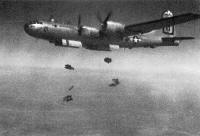
Wingman bomb drop over North Korea
(Click picture for a larger view) |
[The following article originally appeared on pages 11-13 of The Pyramidiers, the newsletter
of the 98th Bomb Group/Wing Veterans Association, in August of 2011. Permission to reprint it
on the KWE was granted by Herb Harper, the 98th Historian. All credit for the article goes to
Howard Whitley and The Pyramidiers.]
The mission was planned in order to bomb the rail bridges at Kwaksan, North Korea on June 1, 1951.
Things went wrong on that bright sunny morning. There was a malfunction on our first bomb run.
We had to go around and were on our second run when the F-86s left us. To the best of my knowledge
there was no engagement between F-86s and MiG-15s that morning. I was sitting in the tunnel watching
the MiG formations out of the blister (plexiglass). They looked ghostly white against a blue sky.
I watched the first MiG strike, then scampered down to my radio position, grabbed my flak suit and helmet
and hunkered on the floor. Captain Cook had already made the decision to close the bomb bay doors and
make a run for it. We were at the mercy of thirty MiGs. All I could do was listen on the intercom
to the gunners' calls and empty shells falling into the turret from our four 50 caliber machine guns above
my head. The tail guns were knocked out on the first pass. It seemed like this battle would
never end. Finally, it was over and the tail gunner position had taken a direct shell hit. Thankfully
the gunner was not wounded. The A/C, Aircraft Commander told me to get off an S.O.S. "We're hit
in the wing tank, on fire. Do not know the extent of damage. Will try to make South Korea."
We were sprinkled with flak somewhere along the route, but no major damage. We had taken three shell
hits: in the tail, in the fuselage behind the left gunner (hence the fire in the radar compartment) and
in the wing between the Number 1 and Number 2 engines. God bless the Marine Corps! They came up
in a plane and looked us over. They said the fire was out and we looked fine, except our bomb bay
doors were hanging open. We got to an airfield and told the tower we'd like to land except that we
might bum on the way in. The crew was given a choice again of bailing out or riding the plane down.
One of the crew said, "Hell, we've come this far. We've got faith. Let's go in. We made
a normal landing. Only one of the four B-29 bombers was lost. I don't know why we didn't blow
up. Three MiG shells had hit us. You could look in the hole in the wing and could see gasoline.
You could reach right in and grab a handful. But if one is really trying there are times when there
is always a way out of these types of situations. We dropped our bombs on Sariwon probably at the lowest
altitude we had ever dropped. A 1000 pound bomb stayed on the front bomb bay shackle. I told
the A/C. The bombardier tried to salvo. It was a no go. The A/C said to close the bomb
bay doors and take the bomb with us. About 10 minutes later there was a loud boom. Sunlight
hit me in the face through the bulkhead doors. For an instant, I thought the bomb had exploded.
The bomb had fallen free and buckled the doors so badly they wouldn't close. Gunners said they saw
it explode on a mountain top below. All four B-29s in our group were damaged. One went down, one
went back to Yokota, one went to Kimpo or Taegu and we landed at Pusan. The A/C told us to get out
fast after landing as there was concern a live shell might still be in the plane. No nose wheel exit
for me as I went out the front bomb bay and ran. No shell was found. We flew back to Tachikawa AFB
that night on a NAT C-54 and took a bus to Yokota AFB arriving at 3:00 a.m. Our tent was the center
of attention that morning. It seemed like every 343rd flight crew descended on our tent in jubilation.
We were told that they heard we were shot down. Our missions dwindled after that. When our plane
was brought back from Pusan it was never the same. TDY Widow #6335 was a damaged lady. Captain Warren
Cook as A/C came to Yokota early in 1951 from Travis AFB to replace Major Edward Dickinson who was transferred
to operations. The crew that went down this June 1st, 1951 was Captain Cook's old crew from Travis
AFB with a new A/C. Our crew was designated to pack up their belongings for shipment to their home.
They were our next door tent neighbors. This same crew of TDY Widow #6335 with Captain Warren Cook
as A/C led four B-29s in a flyover for General Douglas MacArthur on April 15, 1951 when he was leaving Haneda
Airport in Tokyo. Colonel David Wade, 98th Bomb Group Commander, was onboard that day. The only reference
to this flyover that I can find is in the paperback, MacArthur's War: Korea and the Undoing of an American
Hero by Stanley Weintraub (page 354). Captain Cook and his crew flew both aircraft on different missions.
Thus I have attached pictures of Miss Tampa and TDY Widow with its crew members.
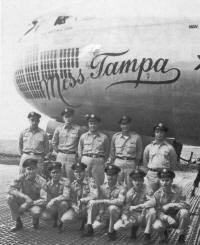
Miss Tampa Crew. Standing left to right: Capt. Warren G. Cook, AC; 2nd Lt. Kay, J.P.; 1Lt. Leonard Gad, N; Capt. Robert Savage, B; 1Lt. Wallace Stephens, VO. Kneeling left to right: Cpl.
Richard Rodgers, LG; Cpl. Robert Busshman, TG; Sgt. Leon Johnson, FE; S/Sgt. Warren Tessmer, CFC; Sgt. Howard Whitley, RO; S/Sgt. Edward Fitzpatrick, RG.
(Click picture for a larger view) |
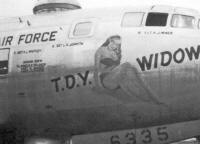
TDY Widow on tarmac at Yokota AB, Japan
(Click picture for a larger view) |
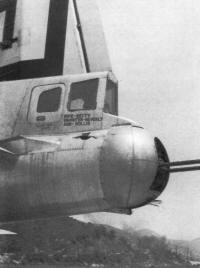
Shell hole from MiG 15, knocking out guns, Pusan AFB, South Korea
(Click picture for a larger view) |
| |
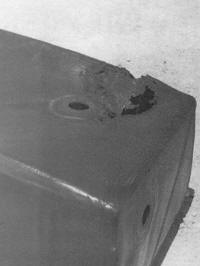
Wing tank damage, Pusan AFB, South Korea
(Click picture for a larger view) |
|
Back to Page Contents Newspaper Articles
Click HERE
Photo Albums
The KWE's B-29 photo albums are divided into three categories: Fatalities/Missing in Action,
Miscellaneous, and Nose Art. The public is invited to add to these albums by sending photographs
that fit into these various categories. The Fatalities/Missing in Action photo album contains
photographs related to the B-29 flight and/or ground crew members who lost their lives during the Korean
War. May they never be forgotten. Our Miscellaneous photo album includes anything else B-29
related that is not specifically nose art. Our Nose Art photo album provides photographs of the artists'
renditions found on dozens of B-29s. Some of them are a little risque, but the B-29s that depicted
them certainly made history! Send your B-29 photo to: Korean War Educator, c/o Lynnita Brown, 111
E. Houghton St., Tuscola, IL 61953 or e-mail them to
lynnita@thekwe.org.
- Fatalities/Missing in Action Photo Album (COMING SOON)
- Miscellaneous Photo Album (COMING SOON)
- Nose Art Photo Album
Back to Page Contents
Remembrance
Families and friends share their recollections and stories about B-29 flight crew members
who paid the ultimate price of freedom while serving in the Far East Air Force during the Korean War.
Click HERE to view the B-29 Remembrance page. [COMING SOON]
Back to Page Contents
Searching for Answers
The Korean War Educator hopes that KWE readers will help us in our search for answers to the
following ongoing research efforts. If you know the answer to any of these mysteries, please let
us know by contacting lynnita@thekwe.org or giving her a call at
217-253-4620 or 217-253-5171.
• Vicious Roomer 44-62042 – We have found the circumstances and names of the fatalities, but have
not been able to find the names of the rest of the crew that day (3//28/52).
• 44-62082 – We have found the circumstances, but other than the name of George Herr, who died in
the bailout, we haven’t been able to find the rest of the crew names that day (7/28/50).
• We have had no luck finding the names of the crew members of Ace in the Hole/SAC’s Appeal
44-61872, although we have found the circumstances of the loss.
• What were the names of the last flight crew members on the B-29 known as Apache?
- Please realize that it is difficult to locate the names of B-29 fatalities not caused by
"operational loss". If anyone knows the name of a B-29 crew member who died due to mechanical
failure or other reasons, and that person's name does not appear on the Losses - Flight Crew page of
the Korean War Educator, please notify us so that we can recognize the fatality.
- Who were the other members of #44-62042 (Vicious Roomer) on March 28, 1952? Known
crew:
- Knott, Cpl. Robert M. - remains recovered
- McIntosh, Rudy - only surviving member of bailout
- McManus, Sgt. Phillip - remains recovered
- Rainey, Cpl. Samuel H. - remains recovered
- Zellars, SSgt. Elliot - remains recovered
- 44-62181 (assigned to 307BW, 372BS) was reportedly shot down in 1951 but there is no KORWALD.
- There were two B-29s known as "No Sweat". The earlier version was 44-87618.
Extensive flak and cannon fire damaged this aircraft during the Yalu River Bridge mission. It
crash-landed at Seoul Municipal Airport with no personnel losses. Its #2 and #4 engines were out and
its hydraulic system was shot out, so the plane had to be salvaged. Who were its crew members?
Back to Page Contents
Steadfast and Courageous: FEAF Bomber Command & the Air War in Korea 1950-1953
COMING SOON.
Back to Page Contents
Tragedy on Guam - December 17, 1951
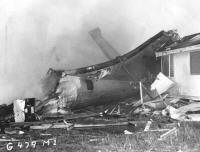
Crashed B-29 on Guam
(Click picture for a larger view) |
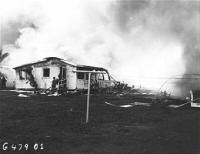
The home of Lt. Col. Benjamin L. Mills, burning after the B-29 crashed into it.
(Click picture for a larger view) |
B-29 (44-87741) had taken off from Guam on its way to its base near Mountain Home, Idaho when one
of the engines failed about 15 minutes after takeoff and the crew turned around to go back to Guam, which
is 3,700 miles west of Hawaii in the Pacific Ocean. During emergency landing at Anderson AFB, Guam, on December
17, 1951, the plane failed to reach the runway and crashed into an officers housing area at the base, demolishing
ten homes and damaging three more. Nine of the 16 crew members were killed, as were seven on the ground--an
officer, his wife, and five children. The plane was damaged beyond repair and written off. [See
News Clipping section for more details.] The crew members were:
- Backman, A/1c William J. - tail gunner - survivor
- Christopher, 1Lt. Dominick J. - navigator - fatality
- DeBoer, 1Lt. Howard L. - bombardier - fatality
- Duran, A/2c Roberto - passenger - survivor
- Graham, A/2c Nelson H. "Nub" - passenger - survivor
- Jensen, A/2c Robert L. - electronic counter-measure operator - survivor
- Larsen, 1Lt. Sophus E. "Eddie" - co-pilot - fatality
- Leard, Sgt. Fred - passenger - fatality
- Murray, A/2c Francis L. - passenger - fatality
- Newby, A/2c Walter R. - passenger - survivor
- Oetgen, 1Lt. Henry G. - pilot - fatality
- Patton. 1Lt. Jack - radar officer - survivor
- Pickrell, SSgt. Homer A. - left gunner/scanner - fatality*
- Reilly, T/Sgt. John M. - flight engineer - fatality
- Van Doren, A/1c Donald C. - waist gunner/scanner - survivor
- Wagner, A/3c Donald J. - passenger - fatality
*Homer Pickrell risked his life to save that of Bob Jensen. He died of injuries the following day.
In 1958 his father accepted the Soldiers Medal posthumously for his heroism. There were more fatalities
(10) and injuries (14) on the ground than in the aircraft. The fatalities included:
- Kimball, Bonnie "Bunnie" Ruth - eleven-year old daughter of Capt. Stanley
Jerome Kimball and Ruth Wilson Kimball. Captain Kimball was the base weather officer with the
54th Weather Squadron
- Mills, Agnes - wife of Lieutenant Colonel Mills
- Mills, Lt. Col. Benjamin L. - 3rd Aviation Field Depot Squadron commander
- Mills, Helen - five-year old daughter of Agnes and Benjamin Mills
- Mills, Margaret - nine-year old daughter of Agnes and Benjamin
- Mills, Martha - two-year old daughter of Agnes and Benjamin
- Orken, Maj. Gerald A. - medical officer and commander, 6319th Dispensary
- Orken, Shirley - wife of Major Orken
- Orken, Steven - three-year old son of Gerald and Shirley Orken
- Orken, Vivian - five-year old daughter of Gerald and Shirley Orken
Back to Page Contents
Tragedy at Fairfield-Suisan AFB - August 5, 1950
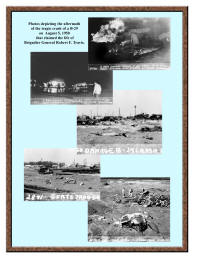
Images of the Fairfield-Suisan AFB Crash
(Click picture for a larger view) |
Although this aircraft was not destroyed in the Korean theater of war, the crash of B-29 44-87651 occurred
during the Korean War and was a devastating loss to our country's Air Force and civilian community. [See
also: Airplane Crashes - KWE.]
According to the official government accident report:
"On 5 August 1950, B-29, SN 44-87651, crashed, burned, and exploded 5 minutes after takeoff from
Fairfield-Suisun AFB, CA, causing fatal injuries to 12 crewmen and passengers. Eight crewmen and passengers
received minor injures. Extensive damage to private and government property and injuries to both civilian
and military personnel were caused by a subsequent explosion of the bomb on the aircraft. The pilot,
Captain Eugene Q. Steffes, was at the controls, with Brigadier General Robert F. Travis acting in command
pilot capacity. At 2200 PST, the aircraft was cleared for takeoff on runway 21 left, which is 8,000
feet long. The wind was 17 knots from the southwest. A full power check (2,800 ROM and 48 inches) was
made, and the brakes were released for takeoff. Just prior to liftoff, the number two engine propeller
malfunctioned, and the aircraft commander ordered the number two propeller be feathered. After liftoff,
the pilot actuated the gear switch to the up position, and the gear did not retract. Due to the increased
drag (feathered number two engine and the lowered gear), the rising terrain ahead and to the left, and
the inability of the aircraft to climb, the aircraft commander elected to make a 180-degree turn to
the right back toward the base. Upon completion of the turn, the left wing became difficult to hold
up. The aircraft commander allowed the aircraft to slide to the left to avoid a trailer court. A crash
landing was imminent as the altitude of the aircraft was only a few feet above the ground. The aircraft
struck the ground with the left wing down at approximately 120 mph. All ten people in the rear compartment
were fatally injured. General Travis and one passenger in the forward compartment received fatal injuries;
all other crewmembers and passengers escaped with only minor injuries."
About twenty minutes after the crash occurred, the high explosives in the bomb casing ignited. The blast,
felt and heard over 30 miles away, caused severe damage (16 trailers and their contents destroyed and many
others badly damaged) to the nearby trailer park on base. In addition to those killed or injured in the
initial crash, as a result in large part to the explosion that occurred shortly after the crash, 180 military,
civilian and dependents were killed or injured. (Seven people were killed, 49 were admitted to the hospital
and 124 others received superficial injuries.) Fairfield-Suisun AFB was later renamed Travis AFB.
At the time of the crash, the aircraft was carrying a significant bomb load. According to the Travis
Heritage Center:
"On August 5th, 1950, Communist troops came across the Naktong River to southwest and northwest of
Taegu on the Korean peninsula. They begun filtering troops to the rear of American lines, forming a
tense political situation. The perimeter around Pusan was forming. The increasing hostilities, and the
North Koreans numeric superiority left few options for the United Nations and American ground forces.
But, on that day, a Mark IV nuclear bomb was dispatched to the eastern Pacific. It would travel in two
parts. One part, the dense uranium core, and the other, the high explosive outer casing, would each
be carried to the area via separate aircraft, routes, and times. A B-29 bomber left Fairfield-Suisun
Air Force Base on August 5th, 1950, carrying the high-explosive portion of the Mark IV. ... About twenty
minutes after the crash occurred, the high explosives in the bomb casing ignited. The blast, felt and
heard over 30 miles away, caused severe damage to the nearby trailer park on base."
Back to Page Contents
The Crew List:
- Braz, 1Lt. William G.- bombardier - survived the crash
- Brotherton, 1Lt. Robert G.
- Cox, Capt. Jack R.
- Gould, Pfc. Jack Lloyd - fatality
- Johnson, 1Lt. Carter W.
- Judd, Pfc. Merrit Donald - born 8 November 1930 - fatality
- Knapp, S/Sgt. Lloyd Francis - born 19 April 1922 - fatality
- Maconi, S/Sgt. Joseph - born 2 December 1925 - fatality
- Mclelland, M/Sgt. James Land - born 27 November 1910 - fatality
- Midura, 1Lt. Matthew A.
- Moore, TSgt. Donald W.
- Prachinack, S/Sgt. Joseph - born 26 October 1913 - fatality
- Reeve, Pfc. Leonard Andrew - born 10 April 1930 - fatality
- Sellers, Pfc. Roy - fatality
- Steffes, Capt. Eugene Q. - pilot - crawled out of the window and was rescued
- Stubblebine, 1Lt. James Arthur - born 30 July 1924- fatality
- Travis, General Robert Falligant - born 22 December - rescued alive from the cockpit area but died
of wounds en route to the hospital - fatality
- Tucker, Cpl. John L. - born 10 February 1930 - fatality
- Vanderpool, Sgt. Richard D. - born 27 February 1924 - fatality
- Voyce, 1Lt. Charles J. - aid to General Travis (1921-2003)
Back to Page Contents
Fatalities (non-flight crew):
- Bender, Pvt. Emile Jr. - base firefighter
- Boyles, Pvt. John - volunteer from food services
- Goins, Pvt. Edward - base firefighter
- Hanstead, Cpl. Doyle - base firefighter
- McCollum, SSgt. John - base firefighter
- Ramoneda, Sgt. Paul Prosper - volunteer from food services*
- Vetter, Pfc. William - base firefighter
*Ramoneda was a decorated World War II Marine Corps veteran. A volunteer from food services that
day, Sergeant Ramoneda died while attempting to rescue 12 passengers and crew trapped aboard the B-29.
He was posthumously awarded the Soldier's Medal, Purple Heart, and the Cheney Medal (awarded annually since
1927 for an act of valor, extreme fortitude or self-sacrifice in a humanitarian interest performed in connection
with aircraft). The Travis Airman Leadership School was later named in his honor.
Back to Page Contents
Cheney Award Citation:
"This is to certify that the Cheney Award Board has selected Sergeant Paul P. Ramoneda as a member
of the United States Air Force to receive the Cheney Award for the year 1950 in recognition of his act
of valor and extreme courage on 5 August 1950. After a gas and bomb laden B-29 type aircraft had
crashed and started to burn very close to his place of duty, Sgt. Ramoneda, with the aid of other members
of his Squadron, assisted several of the dazed crew members from the wreckage. When they were
advised that bombs and ammunition were aboard the blazing plane, most of the rescuers retired to points
of safety, but Sgt. Ramoneda, after remarking to his comrades that he was going to "save those men",
threw a cloth over his head and face and ran back into the inferno. He was seen approaching the
plane at the moment of the explosion which cost this courageous airman his life. The valor, extreme
fortitude, and devotion to his fellow airmen displayed by Sgt. Ramoneda exemplifies the highest traditions
of the United States Air Force."
Back to Page Contents
Yalu River Bridge Mission
There were railroad bridges linking North Korea with Antung, Manchuria during the Korean War. These
bridges, located between Sinuiju, North Korea and Dandong, China, allowed Communist aggressors to transport
manpower, machinery, weapons, ammunition, and other supplies into the Korean war zone. On April 12,
1951, the railroad bridges became the target of 300 tons of Allied bombs carried to their targets on a daytime
mission by 48 B-29s of the 19th, 98th, and 304 Bomb Wings. The B-29s were escorted by 34 F-84s, 18
F-86s, and 24 F-80s. The formation of Allied aircraft was attacked by 36 Russian MiGs from the 176th
GvIAP and 196th IAP, ending in devastating results for the Allies. Back to Page Contents
Allied Losses (B-29s):
| Aircraft Serial Number |
Nose Art |
Unit |
Crash Site |
| 42-65369 |
- |
19BG/93BS |
Kadena |
| 44-61835 |
Dragon Lady |
19BG/30BS |
Suwon |
| 44-62252 |
- |
307BG/371BS |
Suwon |
| 44-69682 |
Hot Box |
19BG/93BS |
Target area |
| 44-86370 |
Lucky Dog |
19BG/93BS |
Ditched |
| 44-87618 |
No Sweat |
19BG/30BS |
Seoul |
| 44-86343 |
Wolf Pack |
307BW/371 BS |
Target area |
-
42-65369 (names Black Sheep and City of Jackson were associated with this serial number)
- This aircraft crashed and burned at Kadena. Capt. Jack W. Frost was the pilot.
-
44-61835 (Dragon Lady) -
-
44-62252* -
- Although this plane was shot down, all of its crew members survived. The crew in the back half
bailed out in North Korea and were all captured. The crew in the front of the plane bailed
out in South Korea, and all were rescued. The plane crashed near Suwon. The crew members
were:
- Adams, SSgt James Q. - Radio (rescued)
- Armstrong, 2Lt. Harold A. - Co-pilot (rescued)
- Brand, 1Lt. John H. - Bombardier (rescued)
- Chenault, Capt James M. "Champs" - Plane Commander / Pilot (rescued)
- Low, 2Lt. James E. -Navigator (rescued)
- Hannemann, SSgt. William R. - Left Gunner - Bill Hannemann was a substitute left scanner
for Tech Sgt. Ralph A. Hixson who was on sick call that day. (POW - repatriated)
- Hearn, Capt. Joseph S. - Not a regular part of the crew. Joe ran the radar shack on the
base was getting in his monthly flying time. (POW - repatriated)
- King, A/1C Marvin E. - Right Gunner (POW - repatriated)
- Knego, 1Lt. George J. - Electronic Counter Measures (ECM) - George was not a regular member
of the crew. He flew as the ECM officer on a plane that was ordered to perform enemy radar-jamming.
George would fly with any crew assigned to that plane. (POW - repatriated)
- Metz, SSgt. Henry X. - Central Fire Control gunner (CFC) (POW - repatriated)
- Moree, SSgt. Leonard- Radar shack ground personnel who was along for the ride for the experience.
(POW - repatriated)
- Oldewage, TSgt. Daniel H. - Tail gunner (POW - repatriated)
- Whitfield, SSgt. Andrew J. - Flight Engineer (rescued)
*Author Dan King is the son of Marvin E. King, one of the crew members on this aircraft.
According to his website (http://www.historicalconsulting.com/aboutme.html):
"Dad's plane serial number was 44-62252, a WWII era B-29 of the 371st Bomb Squadron, 307th Bomb
Group out of Kadena, Okinawa. Their plane was acting as the Electronics Countermeasure Aircraft
for that particular bombing mission. Its job was to confuse enemy ground radar through the use of
electronic jamming equipment combined with the dropping of aluminum foil strips called chaff. It
was in the slot (last) position of the 2nd group (of 3 groups) which put it in the middle of the
3 groups. There was some space between each group. There were 3 fighter squadrons assigned to guard
the B-29s but only two showed up. The "low cover" squadron failed to meet up for whatever
reason, leaving the planes open to attacks from below. Dad's B-29 had some engine trouble (from
age) causing it to slow down, so rather than force its own group to slow down it dropped from the
last spot of the 2nd group back to become the LEAD plane of the next group (the 22nd Bomber Squadron).
It was during this brief unfortunate window that the Russian piloted MiG15s attacked, and finding
a lone B-29 all by itself between two groups, hammered it from the sky. The men in the front half
of the plane stayed with the aircraft until it got far enough south, then bailed out and were all
brought to safe lines by South Koreans or Turkish troops. The plane crashed in a placed called Suwon,
in South Korea."
-
44-69682 (Hot Box) -
- When 15-20 MiGs attacked this aircraft, its #2 engine caught fire, and then the entire wing
caught fire. The aircraft exploded and crashed into a mountain. The tail gunner of B-29
6323 observed the crash and saw no parachutes, but there is strong evidence that some of the crew
survived the attack and were taken POW. Crew members were:
- Aaron, 1Lt. George N. of New York, New York - born July 16, 1917. Remains returned
1994. Reports stated that he died April 22, 1951 during friendly fire strafing.
- Bergmann, Sgt. Louis Henry of St. Paul, Minnesota - born May 01, 1926
- Bevans, Sgt. Robert Warren of San Rafael, California - born December 18, 1913
- Bullock, 2Lt. Elmer Trombly of Portsmouth, New Hampshire - born November 19, 1922.
Remains recovered 1994.
- Elsman, Sgt. Ralph Jr. of Los Gatos, California - born August 07, 1924
- Hatfield, Lt. Col. Douglas Hampton of Shenandoah, Virginia - born August 07, 1919.
He was a POW, held after the war and not returned in Big Switch.
- Simpson, Capt. Richard Harold of Fairhaven, Michigan - born July 25, 1923
- Wilson, 1Lt. James Swayne Jr. of Memphis, Tennessee - born September 21, 1921
-
44-86370 (Lucky Dog) -
- The #1 engine of this aircraft caught fire and was ditched. Debris and an oil slick were
found, but no parachutes were observed and all but one of the 12-man crew remain missing in action:
- Burch, Sgt. Hugh Maynard of New Carlisle, Indiana - born April 22, 1930
- Carlson, MSgt. Albert Bertie of Lebanon, Missouri - born October 08, 1918
- Connolly, 1Lt. James Joseph of Jersey City, New Jersey - born April 29, 1921
- DeCesare, Maj. Anaclethe Patrick of Providence, Rhode Island - born January 13, 1918
- Delgado, Capt. Raymundo of El Paso, Texas - born March 15, 1919
- Dinger, SSgt. Allen Charles of Punxsutawney, Pennsylvania - born June 21, 1929
- Goodwin, 1Lt. Bobbie Alfred of Ada, Oklahoma - born April 11, 1926
- Henson, SSgt. Shields Taylor of Cincinnati, Ohio - born May 20, 1927
- Higgins, SSgt. George W. of Morristown, Tennessee - born February 22, 1928. His remains
were recovered on April 17, 1951 by a surface vessel. They were returned to the USA and
interned at Jarnagon Cemetery on January 02, 1952 with full military honors by the USAF from
Dalton AFB in Greenville, South Carolina.
- Kirby, SSgt. Fred Stephenson Jr. of Richmond, Virginia - born July 12, 1925
- Rudat, Capt. Fred Otto of Columbus, Nebraska - born July 11, 1920
- Winters, Capt. Melvin Percy of Tecumseh, Oklahoma - born February 19, 1925
-
44-87618 (No Sweat)* -
- Extensive flak and cannon fire damaged this aircraft during the mission. It crash-landed
at Seoul Municipal Airport with no personnel losses. Its #2 and #4 engines were out and its
hydraulic system was shot out, so the plane had to be salvaged. Crew members unknown.
*[According to Frank "Bud" Farrell, there were two B-29s with the name "No Sweat". This one
(44-87618) was the earlier version. It made an emergency landing at Seoul following the Yalu
RR bridge mission, but an F-51 was reported to have crashed into it on takeoff, destroying it.
The serial number of the later version of No Sweat was 470134, 93rd Bomb Squadron.]
-
44-86343 (Wolf Pack) -
- A Russian MiG shot this aircraft down over the Suiho Hydroelectric Plant. Of its 12-man
crew, only one (A1C Fred Parker) survived. Missing in action are:
- Bloesch, 1Lt. Fred Ernest of San Diego, California - born June 16, 1917
- Brown, MSgt. Nelson Marion of Ellston, Iowa - born August 08, 1917
- Hobday, A1c Jimmie Rowland of Cortez, Colorado - born May 26, 1932
- Kelly, 1Lt. Henry Bradford of New Orleans, Louisiana - born August 07, 1925
- Kelly, A1c James William of Midwest City, Oklahoma - born January 02, 1920
- LeBaron, A1c James Robert of Healdsburg, California - born October 26, 1932
- Lowe, Capt. James Alfred Jr. of Roanoke, Virginia- born January 07, 1921
- Peters, 1Lt. Spiro Joseph of Rochester, New York - born June 08, 1925
- Phillis, 1Lt. William Kay of Philadelphia, Pennsylvania - born January 24, 1923
- Royer, 1Lt. Ted Grover of Houston, Texas - born September 06, 1920
- Trosclair, A1c James Oliver of McKinney, Texas - born April 24, 1930
Back to Page Contents
One MiG Destroyed
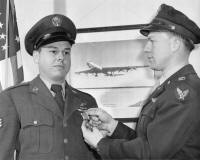
Lyle Patterson receiving a Distinguished Flying Cross.
(Click picture for a larger view) |
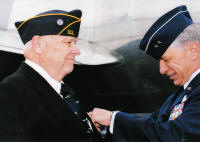
Lyle Patterson receiving a Distinguished Flying Cross.
(Click picture for a larger view) |
Only one MiG was destroyed in the aerial combat that day--shot down by Lyle R. Patterson, a central fire
control gunner on the aircraft "Miss N.C.", 30th Bomb Squadron. During his service in the Korean War,
he flew 31 combat missions, including the Yalu Railroad Bridge mission on April 12, 1951. Years later,
he recounted what happened that day:
"We took off at 5 a.m. from Okinawa, which would put us over the bridges about 10 a.m. After hitting
the IP [initial point] and starting our bomb run, I saw shiny little arrowheads dropping down on the
flight that was ahead of us-MiG-15s. Their swept wings made them look like small arrowheads at a certain
distance. Every one of them had the natural polished aluminum except for the big red stars, and as they
came out of the sun, they really glinted.
Our escorts on this day were straight-wing F-80s. They mixed it up with the attacking MiGs, but the
latter had a great advantage in speed. Seconds later, I saw a big red tracer come whizzing by our tail,
a narrow miss. We were fighting back with our .50-caliber guns, but there were MiGs everywhere. The
B-29 that was right behind us took a 37mm hit in the wing and began streaming fuel as it listed to the
right and fell out of formation, heading down. Our lead bomber, Dragon Lady, took a hit in the left
side of the cock pit, killing the pilot. They stayed on course and dropped their bombs on target, with
the copilot handling the controls. Minutes later we were attacked from our 8 o'clock position, and I
put my sight right on the MiG's cockpit area while firing about 20 rounds. All impacted on his cockpit,
and it immediately started tumbling tail over nose."
[Source: Warren E. Thompson, "Superforts vs. MiGs: over Korea, prop-driven bombers tackled an
unfamiliar mission and faced Soviet-built jets for the first time", Aviation History, May
2013.]
After his discharge from the Air Force, Lyle Patterson became a high school teacher, coach, and principal
in the State of Washington. In 1998, he finally received a Distinguished Flying Cross for the kill
in 1951. Born in a log cabin in 1929, Paterson died on October 19, 2013 after a long illness.
His obituary is located on the KWE.
His DFC citation reads as follows:
"Sergeant Lyle R. Patterson distinguished himself by extraordinary achievement while participating
in aerial flight as a central fire control gunner of the 30th Bombardment Squadron, 19th Bombardment
Group, Medium, on 12 April 1951. In the vicinity of the target area, the vital railroad bridge
at Sinuiju, North Korea, his formation which was flying at 17,000 feet was subjected to repeated and
aggressive enemy fighter attacks. Sergeant Patterson singed out one of the MiGs which was beginning
its attack from seven o'clock high and waited until the enemy fighter was in range. He commenced
firing bursts from both upper turrets. The enemy jet fighter fell away in a tail forward position,
then rolled over on a wing and out of control and was seen to hit the ground. Sergeant Patterson's
courage, skill under fire and devotion to duty reflected great credit upon himself, the Far East Air
Forces, and the United States Air Force."
Back to Page Contents
Black Underbellies
Soon after the disastrous daytime mission at the Yalu, raids began to take place at night. The
underbellies of B-29 Superfortresses were painted flat black to make it harder for searchlights to spot
them during the night missions.
Back to Page Contents
Readers' Comments
|
| |
[Submit your comments on the Korean War Educator's B-29 page to: Lynnita Brown, 111 E. Houghton St.,
Tuscola, IL 61953; lynnita@thekwe.org; ph. 217-253-4620 (home).}
|
| |
| |
| |
| |
| |
|




